Table of Contents
LESSON 8: The Post-War West and the 1876 Centennial
WHAT TO READ, WATCH OR LISTEN TO BEFORE CLASS.
From your textbook, American Encounters:
- In Chapter 9, focus on “The Gulf Stream,” 1899, by Winslow Homer, and “Harriet Powers’s Bible Quilts,” c. 1895, pages 289-292.
- Read about Mueller’s Century Vase, c. 1876, pages 293-94; and “The Persistance of the Past: The Colonial Revival,” pages 295 to 296. Focus on the 1876 Centennial Exposition and the contrast between the Corliss engine and the image of the Puritan.
- Browse “The Post-War West,” pages 300-305. Focus on photographs and paintings of the west by Carleton Watkins, Timothy O’Sullivan, and Thomas Moran.
- Browse section on art by the Pueblo, Navaho, and Lakota cultures. Compare to the work of “Buffalo Bill” Cody and Edward Curtis’s The North American Indian, pages 306-319.
- Read “California Baskets and the Arts and Crafts Movement,” pages 350-354. Focus on Elizabeth Hickox’s basket, 1913, and the Tiffany company’s Indian style bowl, 1900.
From the Metropolitan Museum:
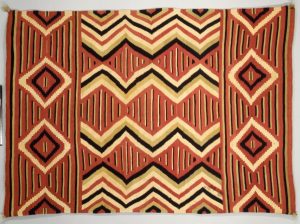
Navaho Blanket, c. 1860-70. The Met’s description explains the blending of European and Navaho methods and materials in this blanket.
From Seeing America by Smarthistory:
- Video (6 min.): “Cities and Pueblos: The Search for an Authentic America,” E. Martin Hennings, Rabbit Hunt, 1925.
- Video (6 min.): “Custer’s Last Stand from the Lakota Perspective,” Henry Oscar One Bull, Custer’s War, c. 1900.
From the Library of Congress:
The Edward S. Curtis collection of photographs from The North American Indian.
WHAT TO SEE, SKIM OR SAMPLE AS TIME ALLOWS.
Contemporary portals to nineteenth century native traditions:
- At the National Museum of the American Indian, an art exhibition by TC Cannon (open until Sept. 16, 2019). See also p. 611 in Chapter 18, “Figures of Resistance,” American Encounters.
- Also at the NMAI-NYC, Jeffrey Veregge, Of Gods and Heroes, October 6 to 19, 2019. A collaboration with Marvel Comics.
- “The Late-20th Century Santero Revival,” p. 504, American Encounters.
LESSON 9: American artists on an international stage.
WHAT TO READ, WATCH OR LISTEN TO BEFORE CLASS.
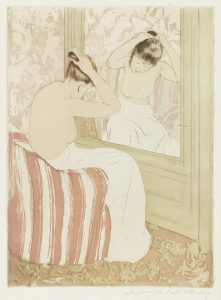
From your textbook, American Encounters:
- Browse Chapter 10, pages 320-338. Focus on paintings by Sargent, Chase, Whistler, and Cassatt.
- In the same section, focus on technology and travel; international expositions; Japonisme; and “The Fine Art Print,” section on page 334.
- Browse “The New American Architecture,” pp. 338-344. Focus on the architects H. H. Richardson and Louis Sullivan; the “Ecole des Beaux Arts”; the importance of Chicago, both the city and the 1893 Exposition; and the development of the skyscraper.
- Go to Chapter 11, “Reasserting Cultural Authority,” pages 377-383. Focus on the concept of the “American Renaissance,” epitomized by Saint-Gaudens and his friend the architect Stanford White; McKim, Mead, and (Stanford) White’s Pennsylvania Station, 1902-10; and the Columbian Exposition in Chicago, pp. 382-383.
- Finally, read about the Kodak camera on page 386, which appeared in time for tourists to take thousands of snapshots when they arrived in Chicago for the 1893 Columbian Exposition.
From Seeing America by Smarthistory:
Video: (6 min.): “A Landmark Decision: Pennsylvania Station and architectural heritage,” about “old” Penn Station, by McKim, Mead, and White, 1912. Grand Central is discussed as well.
- An in-depth look at Louis Sullivan’s Carson Pirie Scott building, 1899, in Chicago
- An in-depth look at Mary Cassatt and Japonisme.
- Video (3 min.): Mary Cassatt, The Child’s Bath.
From the Metropolitan Museum of Art:
Slide shows of paintings by William Merritt Chase, John Singer Sargent, James Abbott McNeill Whistler, and Mary Cassatt, American expatriates who made their careers largely in Europe.
WHAT TO SEE, SKIM OR SAMPLE AS TIME ALLOWS.
A contemporary portal to nineteenth-century Japonisme:
Video from Seeing America by Smarthistory (6 min.): Masami Teraoka, American Kabuki, 1986.
LESSON 10: Contemplation and the chaos of city life
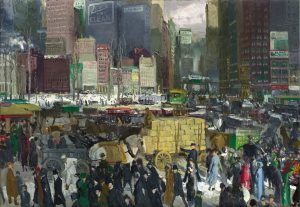
WHAT TO READ, WATCH OR LISTEN TO BEFORE CLASS.
From your textbook, American Encounters:
- In Chapter 10, review “Mary Cassatt and Henry Ossawa Tanner,” pp. 334-335. Focus on Tanner and his religious paintings.
- In Chapter 11, “The Antimaterialist Impulse,” focus on George Inness, pages 359-360. Review the Clover Adams memorial on page 356. Consider whether Inness, Tanner, Saint Gaudens, and La Farge (pages 354-355 and 362) had similar concerns. This might help make sense of abstract painting later on.
- Browse paintings on pp. 362-377 and look for the influence of Japanese composition in Winslow Homer’s Right and Left, 1909. Consider masculinity and heroism in Thomas Eakins’s Gross Clinic, 1875; and Portrait of Frank Hamilton Cushing, 1895. Compare Ellen Day Hale’s self-portrait, 1885, to the other paintings of women in this section.
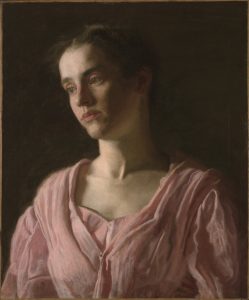
- Read the intro to Part 4 on page 389. Focus on the terms “urban vernacular” and “visual culture,” and what they have to do with modern art and city life. Read the intro to Chapter 12, pages 391-392, and focus on New York City, cultural nationalism, urban realism, and the continuing importance of Japanese composition to American artists.
- Browse “Early 20th century Urban Realism,” pages 392-400. Focus on paintings by George Bellows, paintings and prints by John Sloan, and graphics by Boardman Robinson. Skip ahead to Chapter 14 for comics by Winsor McKay and Lyonel Feininger, pages 470-473.
- Browse the section on photography and modernism in NYC, pages 400-419. Focus on Lewis Hine and Alfred Stieglitz. Compare Hine’s social purpose to Stieglitz’s role as an artist, publisher, and gallery owner.
From the Metropolitan Museum of Art:
- George Inness, Spring Blossoms, Montclair, New Jersey, c. 1891.
- Lewis Hine, child labor photographs: Newsies, 1910; Addie Card, 12 Years, 1910; 7 year old newsboy, NYC, 1910.
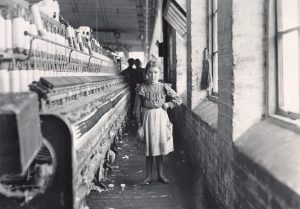
From Seeing America by Smarthistory:
- An in-depth look at Henry Ossawa Tanner’s American paintings, in contrast to the Symbolist approach he took when he moved to France.
- Video (9 min.): Thomas Eakins’s portraits of surgeons in Philadelphia, 1875 and 1889.
- An in-depth look at George Bellows’s Both Members of this Club, 1909. (Compare to Stag at Starkeys from your reading.)
WHAT TO SEE, SKIM, OR SAMPLE AS TIME ALLOWS.
Heroism, boxers, and city life, 80 years after the Ashcan school.
The exhibition Martin Wong: Human Instamatic at the Bronx Museum in 2015 made a big impression on NYC museum-goers. His early paintings refer to his Chinatown neighborhood in San Francisco; the ones from the 1980s were mostly painted from things he saw on the Lower East Side; at the end of his life he went back to his mother’s house and found subjects in her back yard.
(Slide show of the exhibition.)
- Martin Wong, Attorney Street Handball Court, 1982-84, Metropolitan Museum of Art.
- Martin Wong, Down for the Count, 1985, Chrysler Museum of Art, Norfolk, Virginia.
Print this page



